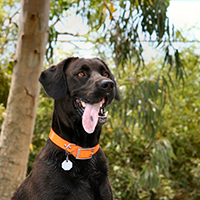It’s every pet owner’s worst nightmare – you come home from a long day at work only to find your window propped open and your cat missing. Or maybe your toddler opened the door and the dog wiggled through to freedom.
We all plan to eventually get those ID tags and microchips for our pets. It is easy to forget about these things until the day you really need them – when your furry friend goes missing. Up to 10 million pets get lost each year, and only a small percentage are reunited with their owners. BCHS took in more than 250 lost pets in 2015. Having proper, up-to-date ID tags and microchips can greatly increase the chance of finding a lost pet. This is why the American Humane Association decided to remind everyone that Every Day is Tag Day™ on the first Saturday in April, and we think that’s a great idea.
It is easy to forget about these things until the day you really need them – when your furry friend goes missing. Up to 10 million pets get lost each year, and only a small percentage are reunited with their owners. BCHS took in more than 250 lost pets in 2015. Having proper, up-to-date ID tags and microchips can greatly increase the chance of finding a lost pet. This is why the American Humane Association decided to remind everyone that Every Day is Tag Day™ on the first Saturday in April, and we think that’s a great idea.
Many people believe that only dogs or outdoor cats need ID tags. The truth is that all pets, including indoor cats, can get lost and should have some form of identification on them. It is often difficult to identify a lost cat based on pictures or descriptions on “Lost” posters, and a tag with the owner’s phone number will quickly clear up any uncertainty. Of the 141 animals we reunited with their owners last year, only eight were cats.
If your cat resists a collar at first, try slowly introducing one to her for 10 minutes at a time with gradual  increases. Associating the collar with positive stimuli – a tasty treat or some playtime – can also be a great way to win over a skeptical pet. If the noise bothers you or your pet, you can always get a nameplate riveted directly to the collar to reduce that jingling noise. Some companies will even embroider your phone number and the pet’s name directly onto the collar, and laminated ID tags are yet another noise-reducing option.
increases. Associating the collar with positive stimuli – a tasty treat or some playtime – can also be a great way to win over a skeptical pet. If the noise bothers you or your pet, you can always get a nameplate riveted directly to the collar to reduce that jingling noise. Some companies will even embroider your phone number and the pet’s name directly onto the collar, and laminated ID tags are yet another noise-reducing option.
In addition to getting them ID tags, microchipping your pet is an important aspect of pet safety. Microchips are very tiny computer chips injected under the surface of a pet’s skin. Animal shelters and vet offices have scanners that can read the microchip’s unique code and identify the contact information of the owner when a lost animal is brought in. While microchipping is essential, ID tags are typically a faster and easier way to return lost pets.
If you have moved recently or have changed phone numbers, it’s important to remember to update that information for both ID tags and microchips. The minimum information to include on a tag should be a phone number, contact name, and address, but it is helpful to include the pet’s name, and evening/cell phone numbers for the owner. An up-to-date rabies tag and city/county license should also be attached, as this is required by many states.
The bottom line is: there are so many great reasons to get your pets ID tags and so few reasons not to! If your pet ever wanders off, you will definitely be happy you took the time to get them a tag.

